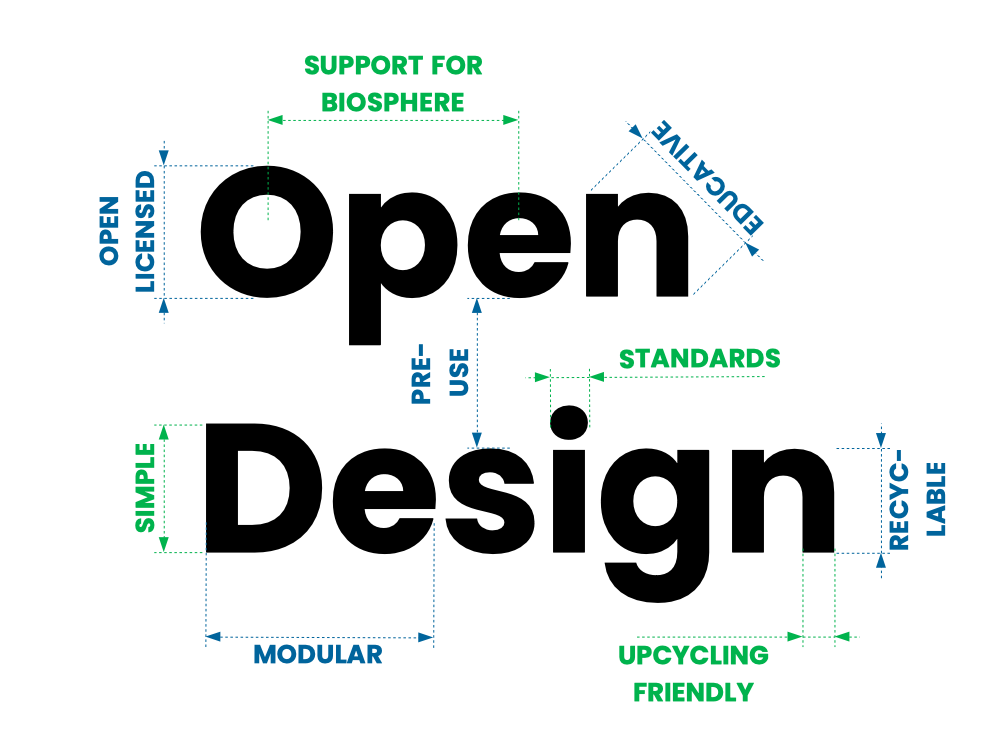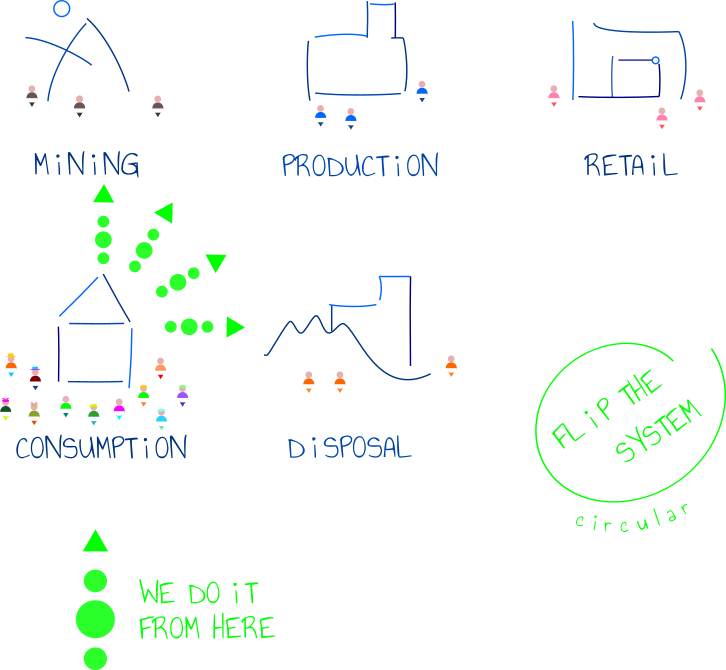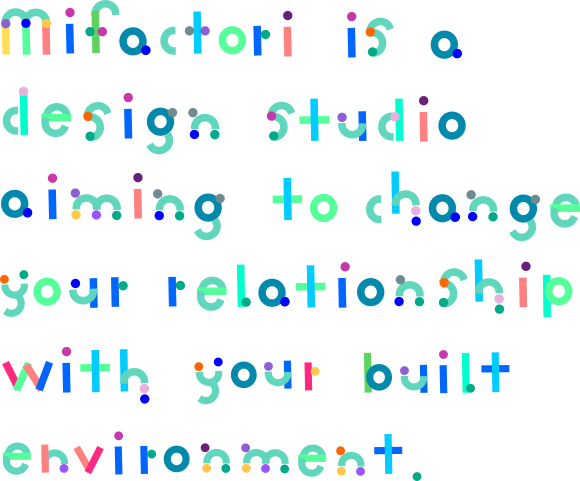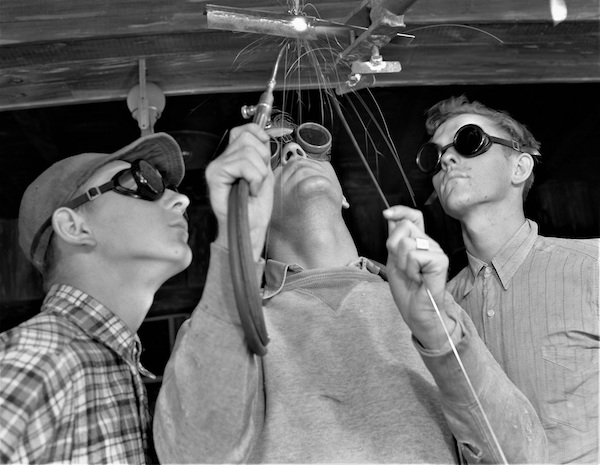Log
- Circular Society Forum, February 2021 (Workshop Announcement)
Link
opencircularity.info/CSF
[ o°]
°
↑ Video Recording, “Slides” ↓
*
Hello,
my Name is Lars Zimmermann, I am a designer + artist, activist and educator from Berlin. I run a design studio for “Open Circular Design” called Mifactori. It is more than a design studio. So this is not just an advertisement talk & workshop.
We are here at an academic conference. So I take the liberty to challenge you a bit – information overload incoming (◎o◎) !
*
1. Open, bottom up, thinking from the point of consumption
*
We think of Circularity as Open Circular Design. We aim for a redesign of the entire economic chain – from linear to circular. But we start from the point of consumption. We are looking for strategies to transform the whole chain from there. So not the other way around as others approach it.
Why & how? The circular economy primarily tells stories about new ways of interaction with products. In addition to purchase, consumption and disposal, there are new activities such as repair, reuse, (reduce) and recycling. These actions must be as accessible as possible to increase their likelihood. So we also give them into the hands of the consumers through design.
–
–
Customers do not shape the circular economy (solely) through their purchasing decisions. Rather, the products are built in such a way that the customers themselves (can) carry out “circular actions” themselves.
*
2 Methods
What distinguishes our studio is that we not only use methods for this goal, but also actively find and describe them .
Mifactori has the half-secret goal of being a meta design agency. We want to inspire other design agencies and give them ideas on how to work effectively for circularity. We want to be copied! For the sustainable transformation of our economy, we need many, many design agencies!
We will look at some of our methods now. We will use the visual from our article “What Is Open Circular Design” as a tour guide.

Simple → Of course everything needs to be simple, or as simple as possible to invite customers to engage differently with design. We like construction toys and the aesthetic of our work is inspired by it. This helps to signal to people that this design is made to be “played” with. Let me show you one of our super simple designs → Ringbein.
Modular → You just looked at a very modular design. And almost everything we do has to do with modularity. Our lead vision is a world designed like worlds made out of Lego Bricks. Worlds where everyone can constantly reuse, rebuild and so on. I’ll show you one of our methods for this → 3erlinGrid.
Upcycling Friendly → To proof that you really enable reuse of materials don’t show me how your design can be reused. Show me a design that enables reuse of materials in high volume and effective mass production. Ringbein ↑ was a good example for an upcycling friendly design. Here is another one the → Schöneberg Stool
Recyclable → We try to use only materials that are recyclable and make sure it is possible to separate different materials quickly. The two designs I just showed you made this clear.
Open Licensed → Openness is the key to circularity. Things have to be designed to be open. But they also have to be licenses accordingly! – When circularity is about enabling new activities you have to make sure that there are no property rights that block these activities (closed source and property rights are means to STOP people from doing things). This means as a designer of sustainable circularity you have to think about licenses. So we use open licenses ourselves and → educate people how to do this. | We participate in the development of Open Source Hardware (which is a broader movement not just for circularity) for example by creating resources about the legal part of it, like our → FAQ to avoid misunderstandings and even → whole campaigns to clean some of them up through collective actions.
Standards → Standards are a classic way to enable circularity for a variety of reasons. But we don’t just use standards we try to invent and find new ways to increase their use. For example by → hacking them. We even propose active research to → find out what are the best modularity standards to use. And we → conduct this research ourselves. And we reflect their effects on our understanding of → what makes a circular “design”.
Support for the Biosphere → I skip this. Because we don’t really have a unique key methodology for this. We will at some point.
Education → Obviously the documentation of our → product designs are pretty educative. “Designs that teach” … But while we talk about “education”: I already mentioned that we work a lot in education. All the → workshops we develop are openly documented for teachers and we provide a → manual/manifesto for teachers to make art and sustainability education sustainable & circular in the means used.
Education II (Activism!) → But I want to use education to highlight another one of our interests – campaigns and activism. We are in the field of sustainability for quite some time now and one thing became clear: A shift to a more sustainable world will not happen without A LOT of activism. So naturally we became interested in campaigns and creative activism. We run & develop campaigns for the → online and → offline world. AND we invite other creative, strategy and design agencies to create → more activist companies out there!
PreUse → The last method in the picture that will guide us to the practical part of the workshop is → PreUse.
*
3 Practical Part
The announcement promised a practical part. And here it is. Let’s make a litte exercise in PreUse – the method I just explained.
The Task → I am sure all of you have a little PreUse hack in your home. Go, find it. If you have none, create one. If you have time left, create one more.
You have __ minutes for this.
Then we will come together. And those of you who want to show their “DIY-Circularity-Hack” can show it. Then we will have discussion.
° ° °
work in progress
–
° ° °
Presentation → Show your work 🙂
*
4 Discussion
Let’s have a discussion.
Do you have questions? Remarks? Do you think Circularity needs to be DIY?
*
5 Thanks
Thank you for joining this workshop. Stay tuned. A lot will happen at Mifactori in 2021 and 2022 – for example we are building a “transparent factory” (° o °). The best way to do this is
→ Our Newsletter \ (* ^ ▽ ^ *) ノ
But we’re also everywhere on social media for example
→ Instagram ,
→ Twitter ,
→ LinkedIn .
Thank you
And again the link to this page:
opencircularity.info/CSF
[ o°]



